Tereza Novotna contrasts the different approaches taken by the Czech Republic and Germany to commemorating the fall of communism and reflects on how these differences illustrate the experiences of those who lived through it.
Twenty years ago, I was only eight years old. Despite of that, 1989 will always remain a year deeply engrained in my memory. Maybe it is just because it was so bitterly cold in those late November days when my parents dragged me to mass demonstrations against the communist rulers in Prague. To keep me quiet, my parents however gave me an important job to do. After each speech, instead of applause, I started jingling the keys, with thousands of others. Since then, even if I was only a child then, I think to myself: “Yes, I did help to put down the communist regimes in Central and Eastern Europe!”
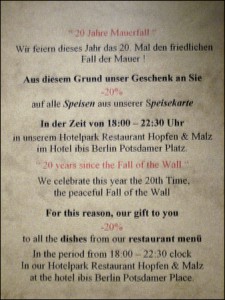
Perhaps because I remember the collapse of communism so vividly, I was very curious to see how these historical moments would be commemorated twenty years on. I therefore decided to travel to two places which I connect most closely with the crumbling of communism– to Berlin and, of course, to Prague. The hotel my husband and I stayed in Berlin was conveniently located in a walking distance from the Potsdamer Platz in 1989 a no-man’s land between the East and West and near to the line where the Berlin Wall used to cut the city through. A menu of the hotel restaurant, advertising “a gift to you, 20% off any meal to celebrate 20 years since the fall of the Wall,” was the first item which reminded us why we came here. I am sure customers appreciated that offer no less than “the Fall of the Wall Special: Travel for Fixed Price of 20 Euro”, marketed by the German railway company.
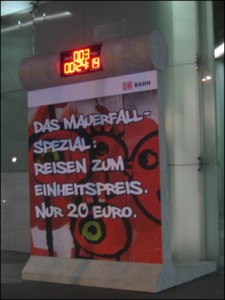
In fact, it was hard to ignore the former East Germany and its demise twenty years ago in Berlin in November 2009. Apart from the regular East German paraphernalia, such as shops with “Ampelmaennchen”, the little traffic light man, the whole city was geared towards the “end of the Iron Curtain”. In just a few days, we managed to visit several temporary art exhibitions, such as photographs by Harald Schmitt, a reporter who watched communism to dissolve all over the former Soviet bloc, a show of film and TV-shots from the night of 9 th November in Berlin in the Film museum, and an open-air exhibition presenting pictures and posters from 1989 at Alexanderplatz. We could have seen much more if we just had several weeks and not only several days to do so.
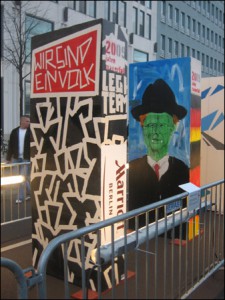
The biggest event though was being prepared alongside the walk from the Potsdamer Platz in front of the Brandenburg Gate up to the Bundestag building, copying the course of the Berlin Wall. Mostly elementary and high school students, but also artists, former dissidents as well as those who are still suffering under authoritative regimes of all kinds, put up and painted over 1,000 “domino stones” so that it all looked like a cheerful and colourful re-enactment of the Wall. The pictures mostly conveyed thoughts about freedom and division (and unification) of the city and country in quite a witty manner, such as a Trabi breaking through a wall or a portrait of Erich Honecker with vampire-like teeth. A smaller number of images however played on a critical note: a domino stone depicting prejudices among East and West Germans and entitled “Against the Wall in the Heads” or, similarly, a stone displaying jokes about Easterners and Westerners. A few of the authors could have boasted themselves having famous figures as their stones’ “godfathers”. For instance, José Barroso “godfathered” one saying “peace and love” and, unsurprisingly, “j’aime Europe”, while another domino stone with Hurvinek, a popular Czech marionette boy, was signed by Vaclav Havel. For sure, it all looked quite remarkable and I was very much looking forward to seeing the dominos falling down.
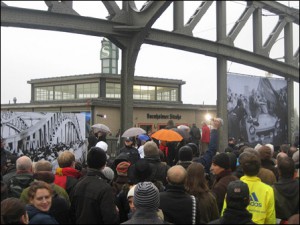
On the D-Day, before going to the evening “Freedom Celebration” with the “domino action”, I visited the former East-West check-point at Bornholmer Strasse. It was actually here where twenty years ago in the late night of 9 th November, the first East Berliners crossed the border and walked over, quite symbolically, the Boese Bridge to West Berlin (“boese” meaning evil or wicked; the bridge was named after a resistance fighter Wilhelm Boese). This time around, several hundreds of people gathered here in the afternoon, waiting for Angela Merkel, accompanied by Mikhail Gorbachev and Joachim Gauck, former East German dissident, pastor, and the first director of the office scrutinizing the Stasi files, to follow with her the path from the Eastern to the Western edge of the bridge. It was definitely the most moving part of the day, not just because of an excellent speech by Gauck. It even did not matter much that Chancellor Merkel admitted to journalists before that she did not pay any attention to developments on 9th November and spent that Thursday evening as usually in a sauna. Yet when she eventually entered the West in 1989, she went through here as well.
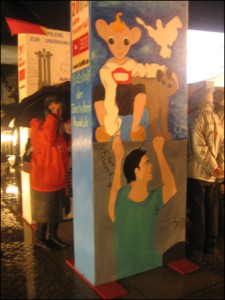
Thinking back about my childhood memories of 1989, days twenty years after felt very similar. Just as two decades ago, it was cold and drizzling with rain but that did not dampen spirits and crowds of cheering people were summoning up alongside the domino wall. I took a spot by the fence surrounding now the domino stones and close to a huge screen hanging on the side of the Brandenburg Gate. The whole event started with a concert by the Staatskapelle, one of the best Berlin orchestras, conducted by David Barenboim. As a surprise for everybody, which brightened up the not so good weather conditions, Plácido Domingo came to sing an old hit and city’s unofficial anthem “Berliner Luft”, followed later by Jon Bon Jovi and Paul van Dyk. The official section included speeches by Merkel and Berlin’s mayor Wowereit, by representatives of the Allied powers – Sarkozy, Brown, Medvedev, Clinton (and a video message by Obama), and interviews with Gorbachev and Genscher.
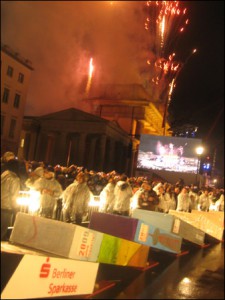
The fun part nevertheless came when the domino stones were pushed and started rolling over. Symbolically, the first stretch was set in motion by Lech Walesa, while the second end was moved by Barroso together with Jerzy Buzek, the European Parliament’s chairman. Since I stood right by the fence, I could clearly see the row of dominos suddenly leaning forward and quickly hitting the ground one after another. Although the view from the street was a bit less spectacular than the aerial sequences showed later on TV, the organizers’ goal to illustrate the “domino effect” of the communist regimes collapsing one after another during the “miraculous year” of 1989 has definitely worked out. The grandness of the moment was even more emphasized by fabulous fireworks above the Brandenburg Gate at the moment when the last stones stumbled down. As a matter of fact, the last two stones did not fall down but were stopped by a genuine piece of the Berlin Wall to symbolize walls around the world which are still standing, be it in Palestine or between North and South Koreas.
After experiencing such impressive festivities in Germany, I was very excited to see what the Czech Republic will have to offer. The first difference which struck me was that there were no official events commemorating the Velvet Revolution to be prepared. Neither government (admittedly, a caretaker government with weak political powers which had other things to do) nor president Klaus (who has always despised Czech dissidents and argued that their influence has been overemphasized) arranged any public event. Vaclav Klaus who was one of the international guests invited to Berlin two weeks before even suggested that he prefers less “grandiose” occasions with people who “were actually there in 1989”. Although Klaus’s criticism was aimed against Merkel who focused on welcoming current dignitaries none of whom was in office twenty years ago, he unintentionally made an interesting point.
In Berlin, nobody recalled former Chancellor Helmut Kohl and his leading role in the unification process after the Wall had been dismantled; only one domino stone remembered Kohl with a German flag as an aura around his head. Similarly, hardly any of the East German revolutionaries and first democratic politicians from 1989/90 took publicly part in the events. Hence Hans-Dietrich Genscher, at the time a foreign minister, was the only participating German representative who “was actually there in 1989”. Ironically enough, Genscher was a head of the liberal party, which was the CDU’s junior coalition partner in 1989 and so is in 2009, and had differences with Kohl over the external side of the post-Wall unification process until it all had been settled in the 2+4 agreement. Perhaps we have to wait eleven more months for commemorations of the German unification to meet all the contemporary leaders again. In any case, in contrast to Germany, celebrations of the Velvet Revolution in Prague were all about Vaclav Havel, a former dissident and probably one of the best known post-communist leaders in Central and Eastern Europe.
To observe the twentieth anniversary, Havel organized privately a concert which was however well covered in the Czech media. Opera diva Renée Fleming and musicians such as Suzanne Vega, Lou Reed, and Joan Baez were among performing artists, while others, such as Mick Jagger, Angela Merkel, and President Obama, send their televised greetings. Indeed, if it were not for Havel and his personal invitations, none of the world’s attention would have been paid to the events in the Czech Republic.
On 17th November, the day of the Prague’s peaceful revolution, a civic group put together re-enactment of the march from parts of Charles University at Albertov to the city center’s Narodni trida where students were massacred in 1989 and which triggered the Velvet Revolution. The march took several hours and was broadcasted on the Czech public television and radio. I joined the crowd in the final phase when people arrived to Narodni trida. It was virtually impossible to go through the arcade where the police acted most violently in 1989 and where there is nowadays a commemorative plaque. After meeting up with friends of mine near a big stage by the Tesco, we watched several musicians onstage. The biggest surprise of the show (for organizers perhaps as well) was Joan Baez who suddenly appeared with her “bednak”, a man bringing along her guitar. This man was nobody else than Vaclav Havel. After Havel’s short greeting, when she started singing a stanza of “We shall overcome” in a cute Czech, it was difficult to hold tears back.
Despite almost omnipresence of the former Czech president, and in contrast to Berlin, the Velvet Revolution’s celebrations all reminded me of a street party or open-air rock concert rather than a political event. Probably that’s why one could observe so many families and mothers with buggies going down Narodni trida. The slightly apolitical atmosphere was from time to time disturbed by posters frequently protesting against the current president Klaus and, for instance, bashing his (too) positive relationships with the Russian leadership or simply asking him to resign.
Before going back home, my friends and I stopped by at Vaclavske namesti where students of Charles University arranged another gathering. About a year ago, they founded a student initiative and entitled it “Inventura demokracie”. Having “taken an inventory” or “check-up” of the Czech democracy twenty years after its commencement, students decided it was high time to reflect on its weaknesses with experts in a series of debates. Moreover, they asked current Czech politicians for a “present to the 20 th anniversary of 89” to remove (and express their views on) “four legislative absurdities”, such as extensive immunity of Czech MPs and unregulated lobbying, which are, according to students, lowering the quality of Czech democracy. The highlight of the students’ undertaking at Vaclavske namesti was reading aloud their final declaration and singing of the Czech anthem.
Even though the students’ activities had a clearer political character, they were not focused on 1989 but on situation in the Czech Republic in 2009. They were more of a protest rather than celebration. This stands in a sharp contrast to happenings in Berlin. The Berlin festivities surely reminded the fall of the Wall but only rarely dealt with the German contemporary troubles, be it a continuous nostalgia for the communist times among East Germans or lack of appetite for pumping more money into the new Bundesländer among West Germans. In addition to that, the German government and city of Berlin (run by opposing coalitions) were in charge of organizing, while the Czechs, disappointed by political parties of all ideological hues, had to help themselves and rely on NGOs, students, and individuals to run the Velvet Revolution’s anniversary.
Perhaps the differences in 1989 commemorations are much more significant than it can seem at the first sight; they reflect developments in both countries in the last twenty years pretty symbolically. In Germany, the common ground between East and West Germans is the dismantling of the Berlin Wall and bringing down communism all around Eastern Europe. The role of the (West) German government in forging one German state is indisputable either. When it comes to inner unification of the country, however, the situation is much more complex. It is therefore quite logical that Germans concentrated on the joint victory in November 1989 rather than on evoking the subsequent difficulties.
The Czech Republic, on the other hand, went through a smooth integration into European structures and democratic transition which, although after twenty years irrevocable, suffers from specific problems: corruption, clientelism, distrust of politicians and politics in general, etc. Hope for the Czechs to remedy these flaws is not the current Czech state, but an increasingly strengthened civil society and new generations unburdened by the communist past. It is therefore also quite logical that non-state actors took care of the twentieth anniversary of 1989 in Prague and concerted their efforts on issues important to them now rather than on issues closely related to the Velvet Revolution. The one exception is Vaclav Havel. Despite a certain period of domestic criticism against Havel around the turn of the century, young Czechs in particular appreciate his moral authority in 2009 as much as they did in 1989. In this sense, he has remained a fixed star of the Czech politics and society for the last twenty years. When we celebrate the next big anniversary since 1989 in ten years time, the generations of the Czechs and Germans born after the collapse of communism will be entering their thirties and advancing their careers. I will be very curious to find out how this will change the ways in which both nations will be commemorating the peaceful revolutions around Central and Eastern Europe in 2019. Maybe this time around, Berliners will not even notice the jubilee, while in Prague, I will be able to join the cheering crowds and jingle my keys again.
Tereza Novotna is a Ph.D. Candidate at Boston University and was a Junior Visiting Fellow at the IWM in 2008.